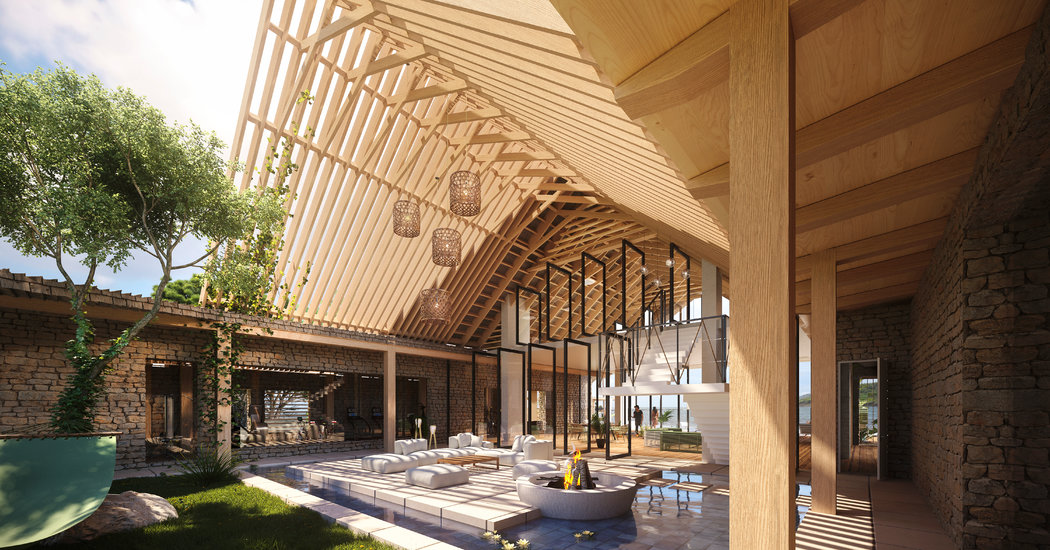
A Stunning St. Lucia Golf Resort Is Really Out of the Way. That’s by Design.
“I’m a property guy,” Mike Keiser says. And for 20 years, since he opened Bandon Dunes on a stretch of secluded Oregon coastline, golfers from around the world have been flocking to his courses.
The property Mr. Keiser refers to has to be ideal ground for golf — sandy soil, preferably oceanside, and just enough character in the form of hills and swales to cause interesting reactions when the golf ball lands on the turf.
His latest golf venture is taking him to the Caribbean island of St. Lucia. “I’ve been there once, and it just takes your breath away,” Mr. Keiser said. “It’s such an exciting site.”
The 74-year old golf developer is “the father of remote golf,” said Ben Cowan-Dewar, Mr. Keiser’s partner in the resort that will become known as Cabot Saint Lucia.
Their previous partnership — Cabot Links in Inverness, Nova Scotia — has two courses in Golf Digest’s latest rankings of the world’s top 50.
When they first met 15 years ago, Mr. Cowan-Dewar was a 25-year old entrepreneur running a golf travel business who saw in Bandon Dunes a successful business model, despite the difficulty of getting there. When it opened in 1999, the most popular way to reach Bandon was a flight to Portland, followed by a five-hour drive south, though some visitors would use the closer airport in the university town of Eugene.
The challenge in getting to Bandon, and later to Mr. Keiser’s other developments — Barnbougle in Tasmania and Sand Valley in Rome, Wis., along with Cabot Links — became part of the allure. (Mr. Keiser is no longer involved in Barnbougle.)
Brad Klein, the longtime former architecture critic at Golfweek and then briefly at GolfAdvisor.com, said, “Mike is great at finding interesting, out-of-the-way places, and traveling to them becomes part of the experience.” Beyond that, though, the key to Mr. Keiser’s success was going after what he termed “retail golfers.” And from understanding that, as he puts it, “one course is a curiosity; two is a destination.”
Matt Ginella, who until recently wrote about travel and architecture for the Golf Channel, said that Mr. Keiser’s vision was not chasing after a prestigious golf championship or even building what are termed championship courses, but “going after avid amateurs.”
“Instead of going after the business where people come and play the course and check it off the box and never come back,’’ Mr. Ginella said, “he was trying to build golf courses that people would come to play and come back to play and come back to play. While everyone was chasing everyone who got paid to play golf, he was chasing everyone that pays to play golf.”
Thus, all his courses are open to the public.
Like Bandon Dunes, Cabot Links, whose two courses hug the Nova Scotia coast, takes time to get to. It’s a three-hour drive from Halifax, the nearest major airport.
After viewing the property that would become his first golf development, a young Mr. Cowan-Dewar sought Mr. Keiser’s advice, and was told that he would need more land than the golf course required.
Mr. Cowan-Dewar went to work assembling the parcels along the Atlantic coast necessary to build out the resort to accommodate lodging and growth, which meant a second course, should the first prove successful. But he lacked the capital to complete the project.
That’s when Mr. Keiser, one of the founders of the Chicago-based greeting card company Recycled Paper Greetings, joined him as the majority owner at Cabot Links. But those roles will be reversed in the Cabot Saint Lucia development. In part, Mr. Keiser said, that’s because he is working on a variety of projects, including a development in Dornoch, Scotland, and three other “exciting sites,” including one in the Rocky Mountains.
Although Mr. Keiser will be involved, Mr. Cowan-Dewar will take the lead on setting the aesthetic of the resort and working with the influential golf design team of Bill Coore and the former Masters champion Ben Crenshaw, whose credits include Sand Hills in Mullen, Neb., and the Plantation Course at Kapalua Resort in Hawaii.
Cabot Saint Lucia is set to open in 2021, and a 50-suite boutique hotel will open in 2022. The partners said they were reluctant to divulge their investment in the property. But the Voice, a St. Lucia newspaper, reported that the National Insurance Company, which runs the pension fund for the island’s government employees and provided a loan for the development, valued the 391-acre property at just over $33.6 million.
Currently, 300 memberships, available only to owners of homes in the development, are being offered, with 130 lots set aside for single-family custom homes. These sites are a mix of beachfront and blufftop estates, as well as luxury villas. The remaining 170 will be sold as flats and townhouses, using the resort’s varied topography from the beach to its hilltops. The prices will range from $750,000 to $10 million.
“The least expensive way to do expensive lodging is to sell homes,” Mr. Keiser said. “The easiest way to finance lodging is to not borrow it from a bank but have friends and acquaintances buy lots and build houses and rent” them out to tourists.
Still, Mr. Keiser’s ethos is that golf comes first.
Mr. Klein, the golf architecture critic, said, “Lots of places that were built in hard-to-find places went bankrupt. Mike builds great courses and is worried more about the quality of the golf and uniqueness of the site, believing people will find their way there.”
Mr. Cowan-Dewar said that in St. Lucia, “we will lead with golf.” He cited Pebble Beach, on the Monterey Peninsula in California, as a place where real estate and world-class golf have been married without any detriment to the beauty of the course or the views of homeowners.
“If you think about Pebble, nobody accused it of being a real estate venture, and yet there are homes lining the course.” he said. “Pebble is the exemplar of putting the homes on the inside and letting the golf have the great land. Those views looking out across the golf and ocean don’t deprive anyone of the view. That was a guiding principle of Cabot Links, where all of our rooms look across the golf course and out at the ocean.”
The same will hold true in St. Lucia, Mr. Cowan-Dewar said. He has enlisted the London architect Richard Evans, who recently designed the Six Senses resort in the Seychelles, to have a unified design for the hotel and housing.
Prospective owners will be able to choose from built properties or luxury flats or to customize their homes from a menu of colors and material.
“We’re looking to maximize privacy and maximize protection from the sun and the wind,” Mr. Evans said, but he added that he wanted guests to “experience the noise of the ocean.”
“I hope you get the best times with your friends and family in this extraordinary place,’’ he said, “but, also, the best night’s sleep, which is one of the greatest luxuries right now.”
Mr. Cowan-Dewar visited the Caribbean four years ago wanting to “solve the winter golf problem” of Cabot Links. “I remind all our American friends that Nova Scotia’s ocean water is the warmest north of the Carolinas, and while we have these really temperate summers with 77-degree ocean water, much like Long Island, we’re not playing golf in December, January and February.”
He was seeking projects that had been scuttled after the recession and that had easy access by air and a shared sense of British history when he “stumbled across this site in St. Lucia, for which Jack Nicklaus had done a routing plan and started construction.” Echoing Mr. Keiser, he said, “It literally took my breath away. I had the same feeling as I did 15 years ago when I went to Inverness.”
But its beauty will pose challenges.
Along with the problem of integrating real estate with golf, Mr. Coore said, the island’s topography and agronomic qualities, in some ways, aren’t ideal. Mr. Coore and Mr. Crenshaw practice what has been termed minimalism in golf course design, which seeks to use what the land has, rather than using heavy equipment to move earth or bringing in additional materials.
Cabot Point, as the course is being called, features a number of rocky outcroppings and soil that will make it challenging to create the style of course that Mr. Coore and Mr. Crenshaw typically build.
Course builders prize sandy soil because it’s akin to sculpture with butter. The St. Lucia property, despite being near the ocean, doesn’t have much of that. Mr. Coore confirmed that they would use a technique called sand capping, which places a layer of sand over the turf to help promote drainage and create the fast and firm conditions golfers prefer.
But Mr. Coore said the real test for his team would be “to create a course that is as enjoyable and playable as the site is spectacular.” He added, “This may be the most spectacular site we will have worked with, and that’s saying something.”








